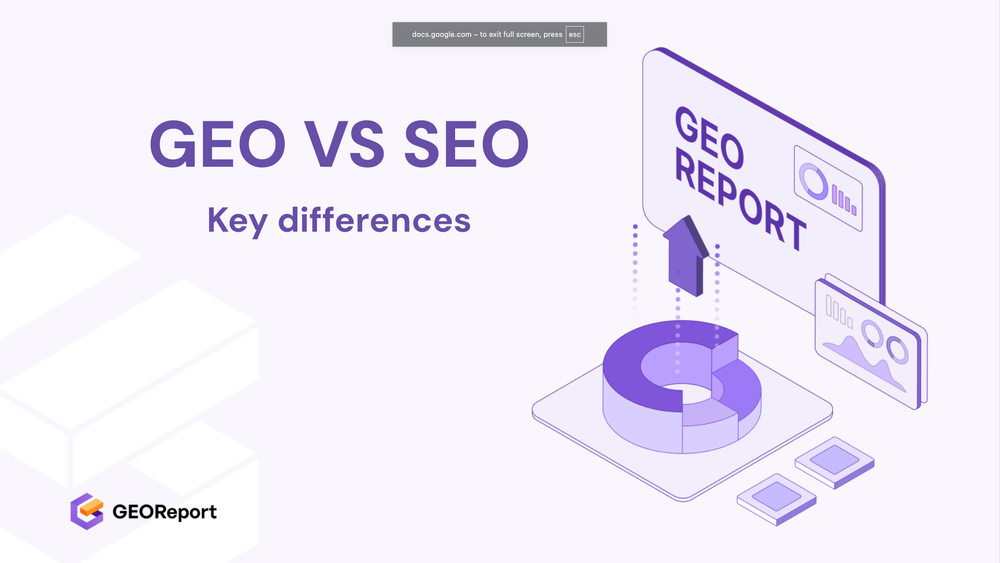BLUF: The difference is that SEO-optimized content aims to rank in Google’s SERPs using keywords and backlinks, while GEO-optimized content is built to be cited by AI models through E-E-A-T, structured data, and machine-readable formats.
Why Does Focusing on Both GEO and SEO Matter for Online Visibility?
GEO (Generative Engine Optimization) and SEO (Search Engine Optimization) are both critical for enhancing online visibility, but they target different mechanisms. SEO focuses on ranking high in traditional search engine results pages (SERPs), while GEO concentrates on increasing a brand's presence in generative AI outputs. Ignoring either can result in missed opportunities.
- SEO Benefits:
- Traffic from Search Engines: High rankings in Google, Bing, and other search engines drive organic traffic to your site.
- Keyword Targeting: SEO allows you to target specific keywords that your audience is searching for, ensuring relevant traffic.
- Measurable Results: SEO provides concrete metrics such as keyword rankings, organic traffic, and conversion rates, making it easy to track progress.
- GEO Benefits:
- AI Visibility: GEO ensures your content is cited and referenced by large language models (LLMs) like GPT-4, Bard, and others, increasing brand awareness and credibility.
- E-E-A-T Enhancement: By focusing on Experience, Expertise, Authoritativeness, and Trustworthiness, GEO improves your brand's reputation in the eyes of AI algorithms, leading to better citation rates.
- Future-Proofing: As AI becomes increasingly integrated into search and information retrieval, GEO ensures your content remains relevant and visible.
According to a study by Princeton University, websites that demonstrate high E-E-A-T are more likely to be favored by search algorithms and LLMs.
Real-World Example: A medical device company optimizing solely for SEO might target keywords like "best CPAP machine" to rank high on Google. However, if they also focused on GEO, they would create expert-led content (e.g., a blog post by a pulmonologist) that emphasizes the device’s clinical benefits, research-backed data, and patient testimonials. This would make their content more likely to be cited by AI models when users ask questions like "What are the most effective CPAP machines recommended by medical experts?"
Which performs better: GEO-optimized or SEO-optimized blog content?
When people ask “What’s the real difference between GEO and SEO?”, the best way to understand it is by looking at how each approach serves a different search environment. The table below breaks down the main contrasts:
| Factor | SEO-Optimized Content | GEO-Optimized Content |
|---|---|---|
| Primary Audience | Google, Bing SERPs | ChatGPT, Gemini, Perplexity |
| Goal | Higher rankings + organic traffic | Being quoted as a trusted AI source |
| Content Style | Keyword-rich, long-form, contextual | Direct, BLUF, structured, schema-ready |
| Freshness | Periodic updates (annual refresh) | Must reflect 2024–2025 data, trends |
| Optimization Tactics | Keywords, backlinks, on-page SEO, technical fixes | FAQ schema, tables, AI-friendly structure |
| Traffic Model | Click-through to website | Zero-click, AI summaries + citations |
| Measurement | SERP rankings, CTR, backlinks | AI citation checks, visibility in AI answers |
Why Both GEO and SEO Truly Matter in 2025
SEO keeps your content discoverable in Google. GEO makes it quotable in AI. You need both to stay visible across all search channels.
The key difference is how users ask questions:
- On Google, a user might type: “best CPAP machine reviews 2025”.
- On ChatGPT or Gemini, they’ll ask: “Which CPAP machines are most recommended by doctors this year?”.
That’s where GEO comes in — it ensures your content is structured, expert-led, and credible enough to be cited directly in AI answers.
The real WHY both matter
- SEO drives traffic: without Google rankings, you miss the millions still searching traditionally.
- GEO drives trust: without AI citations, your brand disappears in the new “zero-click” world where users never leave ChatGPT or Gemini.
Why your brand must be cited by AI
When AI answers user questions, it chooses a handful of sources to reference. If your brand isn’t there:
- You lose authority — competitors will be quoted as the trusted experts instead of you.
- You lose visibility — users won’t even know your site exists if AI skips you.
- You lose future relevance — as more users shift to AI-first search, being absent means being invisible.
💡 Bottom line: SEO gets you found. GEO gets you trusted. Without both, your visibility is incomplete.
What Is the Biggest Mistake Brands Make When Creating Blog Content?
The biggest mistake brands make is focusing solely on keyword rankings while neglecting the broader aspects of content quality that generative AI values. Many brands meticulously track keyword positions and organic traffic but fail to assess and improve their E-E-A-T signals.

- Overemphasis on Keywords: Brands often stuff content with keywords in an attempt to rank higher, leading to unnatural and unreadable content that AI models are less likely to cite.
- Lack of Expertise and Authority: Content is often created by generalist writers without specialized knowledge, which diminishes the credibility and trustworthiness of the information.
- Ignoring User Experience: Many blogs prioritize SEO over user experience, resulting in poor readability, slow loading times, and lack of engagement, which can negatively impact both SEO and GEO.
Contrast: Everyone tracks keyword mentions and organic traffic, but few brands actively monitor and improve their E-E-A-T metrics or assess how often their content is cited by AI models.
Example: Consider a financial advice blog. An SEO-focused approach might target keywords like "best retirement plans." A GEO-focused approach would involve content from certified financial planners, detailed case studies, and transparent disclosures. While both aim to provide information, the GEO-optimized content is more likely to be cited by AI when users ask for trustworthy, expert financial advice.
How Can Brands Implement GEO in Practice?
Implementing GEO effectively involves a combination of content strategy, technical optimization, and ongoing monitoring. Here's a practical guide:
- E-E-A-T Assessment:
- Expertise: Ensure content is created or reviewed by subject matter experts. Highlight their credentials and experience.
- Experience: Include real-world examples, case studies, and personal anecdotes to demonstrate practical knowledge.
- Authoritativeness: Build authority through citations, backlinks from reputable sources, and industry recognition.
- Trustworthiness: Be transparent about your sources, methods, and any potential biases. Include disclaimers and contact information.
- Content Optimization:
- Comprehensive Content: Create in-depth, well-researched articles that thoroughly address user intent.
- Structured Data: Use schema markup to provide context to search engines and AI models.
- Visual Appeal: Incorporate high-quality images, videos, and infographics to enhance user engagement.
- Technical SEO:
- Site Speed: Optimize your website for fast loading times.
- Mobile-Friendliness: Ensure your site is responsive and works well on mobile devices.
- Accessibility: Make your content accessible to users with disabilities.
- Monitoring and Measurement:
- Google Analytics: Track organic traffic, engagement metrics, and conversion rates.
- Semrush: Monitor keyword rankings, backlinks, and competitive performance.
- GEOReport.ai: Utilize GEO-specific tools to assess E-E-A-T, citation likelihood, and AI visibility.
Example Workflow:
- Step 1: Identify Key Topics: Use keyword research tools like Semrush to identify topics relevant to your audience.
- Step 2: E-E-A-T Audit: Assess your existing content for E-E-A-T. Identify areas for improvement.
- Step 3: Content Creation: Create comprehensive, expert-led content that addresses user intent and includes relevant structured data.
- Step 4: Promotion: Promote your content through social media, email marketing, and outreach to industry influencers.
- Step 5: Monitoring: Use Google Analytics, Semrush, and GEOReport.ai to track performance and make adjustments as needed.
What Future Trends Will Shape GEO in 2025 and Beyond?

Several emerging trends are poised to reshape GEO in the coming years:
- AI-Driven Search: As AI becomes more integrated into search engines, the ability to rank in traditional SERPs may become less important than being cited by AI models.
- Personalized Content: AI will increasingly personalize content recommendations based on individual user preferences and needs. Brands will need to create content that is adaptable and relevant to a wide range of users.
- Voice Search: With the rise of voice assistants like Alexa and Google Assistant, optimizing for voice search will become increasingly important. This will require a focus on natural language and conversational content.
- E-E-A-T as a Ranking Factor: E-E-A-T will become an even more critical ranking factor for both SEO and GEO. Brands that prioritize expertise, experience, authoritativeness, and trustworthiness will have a significant advantage.
Contrarian Take: While many predict the death of traditional SEO, it will likely evolve to coexist with GEO. Brands will need to balance the need to rank in SERPs with the need to be cited by AI models. The key will be to create content that satisfies both humans and AI.
FAQs
What Is GEO vs SEO?
- SEO (Search Engine Optimization): Focuses on optimizing content and website elements to rank higher in traditional search engine results pages (SERPs). Key tactics include keyword research, link building, and technical optimization.
- GEO (Generative Engine Optimization): Concentrates on enhancing a brand's visibility in generative AI outputs by emphasizing experience, expertise, authoritativeness, and trustworthiness (E-E-A-T). The goal is to increase the likelihood of content being cited by large language models (LLMs).
Which LLMs Matter Most for AI Visibility?
The most important LLMs for AI visibility include:
- GPT-4 (OpenAI): Powers applications like ChatGPT and is widely used for content generation, question answering, and summarization.
- Bard (Google): Google's conversational AI service, integrated into Google Search and other Google products.
- Claude (Anthropic): Known for its strong reasoning and comprehension abilities.
- Llama (Meta): An open-source LLM that is gaining traction in the AI community.
Can Small Teams Apply GEO Without Big Budgets?
Yes, small teams can apply GEO effectively without a large budget. Key strategies include:
- Focus on Niche Expertise: Concentrate on topics where you have deep expertise and can provide unique insights.
- Leverage Free Tools: Utilize free tools like Google Analytics, Google Search Console, and keyword research tools to analyze performance and identify opportunities.
- Build Relationships: Network with industry influencers and experts to build authority and generate backlinks.
- Create High-Quality Content: Prioritize creating comprehensive, well-researched content that addresses user intent and demonstrates E-E-A-T.
Why Is GEOReport.ai Different From Other Visibility Tools?
GEOReport.ai is unique because it focuses specifically on AI visibility and E-E-A-T assessment. Unlike traditional SEO tools that primarily track keyword rankings and backlinks, GEOReport.ai provides:
- E-E-A-T Scoring: A comprehensive assessment of your content's Experience, Expertise, Authoritativeness, and Trustworthiness.
- Citation Likelihood Analysis: An estimate of how likely your content is to be cited by AI models.
- AI Visibility Reports: Insights into how your content is performing in AI-driven search and information retrieval.
- Actionable Recommendations: Specific recommendations for improving your content's E-E-A-T and AI visibility.
What Metrics Should I Track Monthly?
Key metrics to track monthly include:
- Organic Traffic: The number of visitors coming to your site from search engines.
- Keyword Rankings: The position of your target keywords in search engine results pages (SERPs).
- Engagement Metrics: Time on page, bounce rate, and pages per session.
- Conversion Rates: The percentage of visitors who complete a desired action, such as making a purchase or filling out a form.
- E-E-A-T Scores: Track changes in your content's E-E-A-T scores over time.
- Citation Frequency: Monitor how often your content is cited by AI models and other reputable sources.


